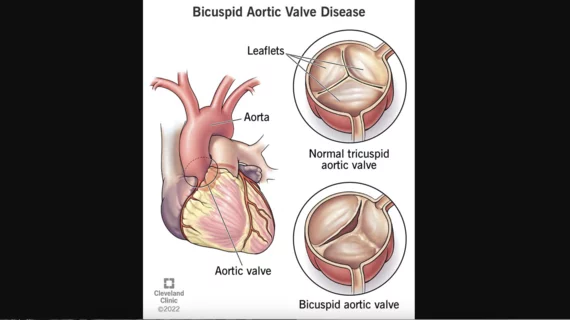How TAVR valve choice impacts outcomes when treating type 1 bicuspid AS
Self-expanding and balloon-expandable transcatheter aortic valve replacement (TAVR) valves are associated with comparable outcomes when treating patients with Sievers type 1 bicuspid aortic valve (BAV) stenosis, according to new data published in JACC: Cardiovascular Interventions.[1] However, each valve type is associated with its own advantages and disadvantages.
“The presence of a BAV poses a significant challenge for TAVR because of increased anatomical complexity, including excessive leaflet and raphe calcification, eccentricity of aortic root anatomy, larger aortic annulus dimensions, and associated aortopathy, particularly in cases of a raphe-type BAV,” wrote corresponding author Giuseppe Tarantini, MD, an interventional cardiologist with the University of Padua Medical School in Padua, Italy, and colleagues. “This subtype is associated with higher risks of TAVR complications and midterm mortality because of the presence of the calcified raphe. Thus, meticulous preprocedural planning is crucial for success.”
Tarantini et al. explored data from more than 900 patients with Sievers type 1 BAV stenosis who underwent TAVR from January 2016 to October 2023. While 56% received a self-expanding TAVR valve, the remaining 44% received a balloon-expandable valve. Decisions about valve type and size were left up to the patient’s care team. A majority of self-expanding valves implanted for this study were Evolut R, Evolut Pro or Evolut Pro+ valves from Medtronic, and a majority of balloon-expandable valves were Sapien 3 or Sapien 3 Ultra valves from Edwards Lifesciences. Researchers emphasized that 41.2% of self-expanding valves had a sealing skirt compared to 100% of balloon-expandable valves.
To make more accurate comparisons, researchers used propensity score matching to focus on 301 pairs of comparable patients; each pair included one patient treated with a self-expanding valve and another treated with a balloon-expandable valve. The median age for these 602 TAVR patients was 78 years old. Men made up 64.5% of patients with a self-expanding valve and 63.1% of patients with a balloon-expandable valve. Patient characteristics were comparable as a result of the propensity score matching, though slightly more patients with a self-expanding valve presented with diabetes. Slightly more patients with a balloon-expanding valve, meanwhile, presented with a history of atrial fibrillation.
In addition, patients with a balloon-expandable valve were linked to larger sinotubular junction and ascending aortic dimensions, but a shorter raphe length.
Tracking outcomes in patients with Sievers type 1 bicuspid aortic valve stenosis
Self-expanding and balloon-expandable valves were associated with comparable success rates. Two intraprocedural deaths were reported, both caused by annulus rupture when implanting a balloon-expandable valve, and second valves were more commonly needed when patients received a self-expanding valve. Ultimately, the composite in-hospital outcome of all-cause death, myocardial infarction, neurologic event, major vascular complication, major bleeding event or renal impairment was seen at a comparable rate in the two groups.
However, researchers noted, permanent pacemaker implantation (PPMI) was more than twice as common in patients treated with a self-expanding valve (17.9%) than patients treated with a balloon-expandable valve (8.6%). Self-expanding valves were also linked to a higher rate of moderate or greater paravalvular aortic regurgitation (7%) than balloon-expandable valves (0.3%).
While rates of 30-day device success and 30-day early safety were higher for balloon-expandable valves, most other 30-day outcomes were comparable between the two valve types. As one might expect, PPMI and paravalvular aortic regurgitation remained more common for patients with self-expanding valves after 30 days. One final notable difference was the fact that severe prosthesis-patient mismatch (PPM) was much more common with balloon-expandable valves (5.4%) than self-expanding valves (1.7%).
Finally, after a median follow-up period of 1.3 years, the authors found that major adverse event rates were similar between the two valve types. This was also true for all-cause mortality and cardiovascular mortality.
“Current-generation balloon-expandable valves and self-expanding valves are effective for the treatment of severe Sievers type 1 BAV stenosis,” the authors wrote. “Compared to self-expanding valves, balloon-expandable valves are associated with a lower incidence of new PPI and moderate or greater paravalvular aortic regurgitation, but with a higher occurrence of severe PPM. Midterm clinical efficacy is encouraging and did not differ between balloon-expandable valves and self-expanding valves.”
The group also noted that “further investigations” into this topic are still required, especially those that feature larger sample sizes and more long-term follow-up data.
Click here to read more in JACC: Cardiovascular Interventions, an American College of Cardiology journal.

